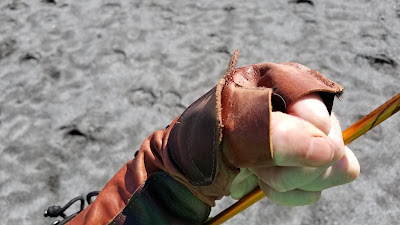The bow I made wasn't perfect. It was a good starting point to learn from. A couple of days later I went back to tweak things.
The first minor fix was to look at the nocks for the string. It didn't seem like the string was going in level or deep enough.
It only popped off once or twice, but I'd prefer zero surprises when shooting. I sanded further down to get a better, even seat.
I didn't get it perfectly even, but the string hasn't hopped off.
The more important fix was to figure out why the string kept smacking my wrist. NUSensei had a video that said a short brace height was a common source of wrist slap.
The brace height is the distance from grip to string. Typically, a recurve bow has a brace height between 7.5" to 9.5". Mine clocked in at 5".
I tied two knots into the string. Really simple knots.
And wow did it make a difference. Each knot added 2"!
I was worried that would be too much, so I went down to one knot.
Which put it just past 7". That was lower than the average according to Google, but I didn't want to make too radical of a change too quickly.
I took all of these measurements with the fiberglass core out. I had stored the bow vertically and it slipped out. I added a little more tape to the center to keep it in place better.
When I reinserted the core, the brace height dropped to just under 7".
It did fix the wrist slap. I may go back and tinker with it more to see how the bow feels with the taller brace height, but for now I'm happy.
My index finger has felt a tad stiff/sore, so I decided to try out Carrie's thumb ring (It's great we already own all this stuff!).
I was a little hesitant, because my thumb never fully healed from the snap. I can't bend it as much as before and it's a little weaker and tender. I may go back to an orthopedist one of these days when the pandemic dies down.
It seemed like a good time to give my index finger a rest, though. I figured the thumb ring would add some protection.
It was different. If anything, it was a great example of how minor changes can muck up a process.
The idea of archery is simple: Nock arrow on string, point, pull back, and let go.
I've been doing Western style archery. The arrow is on the left of the bow and I use a Mediterranean grip (Index finger above the arrow and the next two below).
For a thumb draw, the arrow is on the right.
And frequently on the ground if you're me.
It was frustrating to go from being able to nock automatically and without looking to trying to keep the arrow off the ground.
It was more frustrating when all my shots went wide right. And I mean wide.
Previously, my shots had tended to veer left, so I was all over the place. I got one amazing shot from pure luck, and then only 7 of my 21 other arrows hit the target. I hit 6 arrows on my second set.
For the third set, I tried something: A wrist flick.
A random YouTube suggestion led me to a video on Kyudo (Japanese Archery). They do things differently. Part of their discipline included something about turning their wrist upon release. I noticed it was different, logged it somewhere in my head as interesting, and forgot the specifics.
After a few wild misses, I tried flicking my wrist upon release. It was like night and day. I couldn't believe it.
I hit a set record of 27 points. My previous best had been 26 points.
I tried to recreate the magic for my 4th set. I only scored 16 points, but I hit the target with as many arrows as my first two sets combined.
More research and practice are required.
Searching "Archery wrist flick," wasn't helpful. I eventually found a video that called the motion "khatra." It's a motion in Eastern archery, but not in Western.
I need to play around more with the idea. I'm open to try things to see how they work.
The next thing I may need to practice is my sewing. My guard is showing some wear and tear. I don't have a leather needle, so I may need to improvise with duct tape.


















No comments:
Post a Comment